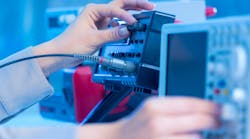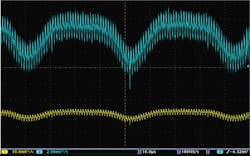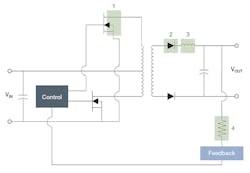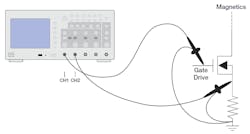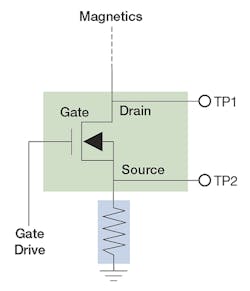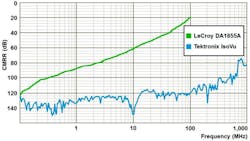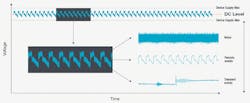Probing Methods that Boost Power-Conversion Measurement Accuracy
Download this article in PDF format.
Most oscilloscopes ship with 10X attenuation passive probes because this type of probe is well-suited to making measurements across a broad range of applications. These probes are typically rated from dc to 500 MHz and generally can handle up to a few hundred volts. It’s certainly possible to use general-purpose probes for power measurements, but the results will unlikely deliver the level of accuracy needed to drive notable performance improvements in the design.
The primary goal for power-supply designers and test engineers is to find incremental improvements that will increase power-conversion efficiency or reduce losses in the design. This requires the ability to accurately evaluate and measure very small performance increases. The strategy is that enough small improvements will add up to noteworthy improvements.
Using a measurement system with sufficient sensitivity, efficiency losses can be found in nearly every sub-section of a power converter, with key areas of interest often involving switching semiconductors, magnetics, and rectifiers. Performance improvements in the low-digit percent values and fractions of a percent can be meaningful. Accurately evaluating and measuring such small performance increases means that highly accurate measurements are of utmost importance.
Signal Sensitivity
General-purpose probes are a must-have for many applications, but there are also times—e.g., many power applications—where something more specialized is needed. Here’s why. A common challenge in power-supply design and measurement is to separate noise from ripple voltage. Now suppose we’re attempting to probe a 3.3-V power supply using a general-purpose 10X probe. Unfortunately, the 10X probe doesn’t provide enough sensitivity to trigger on period noise present in the waveform. These probes are a good choice for many general electronics measurements since they increase the voltage range of the scope and offer relatively high bandwidth.
However, for measuring low-level signals in the tens of millivolts, a 1X (or 1:1) probe may be a better option, because it doesn’t attenuate the signal as much and won’t push the signal down into the noise floor of the scope. Of course, the sensitivity benefit is offset by limited bandwidth, usually around 15 MHz. If this bandwidth is insufficient for your measurement, a passive 2X probe may be a better alternative.
In the application represented by the waveforms in Figure 1, the 2X probe in fact proved to be the right choice. The yellow trace is a 10X probe adjusted to the lowest vertical setting of 10 mV per division and the blue waveform is a 2X probe. The 2X probe can be adjusted down to its lowest vertical setting of 2 mV per division. Since the output of the power supply produces a signal with 3 mV of ripple, it’s clear why a probe with 10X attenuation is not well-suited for this measurement.
1. For a 3.3-V supply, a 2X probe (blue trace) proved to be the right choice. The10X probe is represented by the yellow trace.
Differential Measurements
A ripple measurement such as that just discussed is one application where a single-ended (ground-referenced) probe can be used effectively and safely in power-supply design and debug. But many measurements on power conversion need to be made in a floating environment, where reference to earth ground is not available.
Figure 2 identifies several common power-conversion measurements that aren’t tied to ground and require differential measurement techniques:
- Drain-to-source voltage (VDS) on a MOSFET
- Diode voltage on a freewheeling diode
- Inductor and transformer voltages
- Voltage drop across ungrounded resistors
2. Several differential measurement points, as shown here, come into play when testing a push/pull power converter.
There are several ways to perform differential measurements, including:
- Use two single-ended probes and calculate the difference voltage
- Use an oscilloscope with specially designed floating inputs
- Select a differential probe best matched to the measurement
Two Single-Ended Probes
A common technique is to use two single-ended probes with each probe’s ground lead tied to earth ground and the tips on either side of the component under test (Fig. 3). The oscilloscope is then set to show the difference between Channel 1 and Channel 2. This is sometimes called “A-B” and it displays the difference voltage between the channels using math in the scope. This technique is occasionally used by engineers when they need to make a differential measurement but don’t have the appropriate test equipment available.
3. Quasi-differential measurements can be made using two single-ended probes.
There are several problems with this approach. This method will provide good measurement results only when the probes and the oscilloscope channels are very well matched (gain, offset, delay, and frequency response). This method also doesn’t provide very good common-mode rejection (nulling out any ac or dc portion of the signal that’s common to both inputs). And, if the two signals aren’t properly scaled, you run the risk of overdriving the oscilloscope inputs and getting erroneous measurements.
Floating Inputs
Using a “floating” oscilloscope is another alternative. Each of the input channels of these oscilloscopes is electrically isolated from chassis ground, and then the oscilloscope is powered by its battery. The parasitic capacitance from the oscilloscope chassis to earth ground is also very low.
Together, these isolation characteristics of a floating oscilloscope enable differential measurements with an insulated passive probe. These instruments are convenient, easy to use, and give good results. However, differential voltage probes have lower capacitance and are highly balanced.
Matched Differential Probe
For the best measurement accuracy, a differential probe with specifications matched to the measurement task is usually the best choice. Differential probes are active devices. They include a purpose-designed differential amplifier in the probe tip that measures only the voltage across the two test points, regardless of the potential between either test point and ground. This greatly simplifies the probing task and eliminates some possible sources of error. And since they measure only the differential voltage, they also can ignore—and null out—common-mode ac swings or dc offset voltages that may be present.
Because measurements in different parts of the device under test (DUT) may have very different requirements, it’s important to choose probes carefully. In the example in Figure 4, the task at hand is measuring Turn-on Loss, Turn-off Loss, and conduction loss in the MOSFET switching component of a power supply under test. Shown is a simplified diagram of the MOSFET with measurement points, TP1 and TP2.
4. MOSFET Turn-on Loss and Turn-off Loss are measured at measurement points TP1 and TP2.
Testing a universal MOSFET-based power supply designed to be powered from ac line (or “mains”) voltage in countries all over the world essentially dictates the use of a differential probe. Let’s take a look at the implications for test requirements and equipment.
Input-voltage ratings for this type of device typically range from 80 to 250 V ac or wider. To characterize performance across a variety of input-voltage conditions worldwide, you need to perform not just one measurement, but a series of measurements at several input-voltage levels. This applies to each performance parameter to be tested. Switching characteristics (and therefore losses) can be expected to be different at each of these input-voltage levels, and they may not vary in a linear fashion. This increases not only the total number of measurements to be taken, but also the need for repeatability from measurement to measurement.
With input-supply-voltage levels as high as 250 V ac, the voltage levels between drain and source in the switching MOSFET can be expected to reach 354 V or higher. The probing solution needs to be versatile enough to measure these voltage levels along with much lower levels for some tests.
The power supply under test has a switching rate of 250 kHz. Using the common “5X” rule of thumb for measurement bandwidth, this equates to a measurement bandwidth requirement of 1.25 MHz. However, this is a simplistic view of real-world signal speeds since actual rise times of the switching components can be expected to exceed this by an order of magnitude. The same is possible for spikes, transients, and other noise that may need to be investigated.
If you’re measuring signals with rise times in the tens of nanoseconds, the probe should have a rise-time spec in the nanoseconds. For accurate measurements in this example application, the bandwidth of the measurement system should be on the order of 500 MHz or higher.
Resistive and capacitive loading must be considered, too. Important specs for voltage probes also include input impedance, a key to possible interaction with the DUT that can compromise measurement accuracy by loading the circuit under test. Two key probe specifications are input R (resistive impedance) and input C (capacitive impedance.) A high input impedance R value (in ohms) will minimize circuit loading at dc and low frequencies; a low input C value (in picofarads) will minimize circuit loading at higher frequencies, which can affect timing measurements such as rise time.
Another important factor is common-mode rejection ratio (CMRR), which specifies a differential probe’s ability to reject any signal that’s common to both test points in a differential measurement. In a perfect world, a probe’s CMRR would be infinite. However, most differential probes have limitations in this regard. CMRR in dB describes the ratio of signal “rejected” by the probe to the amount that leaks through and shows up in the measurement. Note that for most differential probes, CMRR declines with frequency.
Stepping Up to GaN and SiC
For some applications, the measurement requirements may exceed the capabilities of even the best conventional voltage probes. In particular, semiconductors based on gallium nitride (GaN) or silicon carbide (SiC) create new challenges for measurement.
For example, switching devices based on GaN offer smaller chip size, low on-state resistance, and the ability to operate at ultra-high frequencies (> 1 MHz) compared to traditional silicon devices. But these desirable performance improvements also create new demands for successful probing and measurement.
The combination of high voltage and higher switching frequency requires a probing solution with extremely good CMRR at high frequency, especially when making measurements such as gate-source voltage on the high-side semiconductor. However, because of their electrical connection to the DUT, conventional differential probes lose CMRR performance as frequency increases.
Consequently, the industry is increasingly turning to probes that use electro-optic sensors to convert the input signal to optical. This approach keeps CMRR from derating as frequency increases, opening the door to measurements on GaN or SiC devices that were previously impossible. This is shown in Figure 5 where an optical differential probe provides near flat CMRR as frequency increases.
5. Isolated optical probes overcome the problem of CMRR derating with frequency.
Power Integrity
Most of today's electronic designs require many different supply voltages to function properly. In fact, many components within a given circuit require multiple voltages. This is especially true with highly integrated system-on-chip and microprocessor designs in which multiple technologies interface together.
Performing dc power-rail measurements is becoming increasingly difficult due to several factors, including power-efficiency features like power gating and dynamic voltage and frequency scaling, dynamic loads with fast transients, increased crosstalk, and coupling and switching regulators with faster rise times. Connectivity can also be challenging since it must have low inductance paths to ground and minimum effective capacitance to reduce ringing and provide the most bandwidth.
Many designs have a bulk supply voltage that filters down through various dc-dc converters to the needed supply voltages required by the various ICs and systems. It’s often the case that the bulk supply voltage is many times higher than the voltage needed by ICs. Because of this, it’s important to choose a probe that offers enough offset to look at all of the rails being tested in a power-delivery network.
In addition, it’s important to look at each dc line to see if the power supplied is within the tolerance band of a target system or device. This includes the nominal dc value of the line, as well as any ac noise or coupling present, as displayed in Figure 6. All of these noise sources impact the quality of power that reaches a device, and it’s important to reduce these noise sources to the point that the target device can operate properly.
6. Components of dc power-supply noise including ac noise and coupling.
However, prior to minimizing these noise sources, they need to be accurately measured. Looking at many power-delivery designs, it might seem that measurement system bandwidths of a few tens of MHz are enough. Most switching designs are switching in the hundreds of kHz up to perhaps a few MHz. Larger physical designs and devices that run off higher supply voltages were less sensitive to noise. So, noise content above 20 MHz was rarely a concern.
Now, as design sizes and supply voltages shrink, tolerances follow. Power-distribution networks are being analyzed more as transmission-line environments, examining things like cross-coupling, line impedances, and resonant regions.
While the fundamental switching frequency of power-conversion devices may be relatively slow, the edge speeds and rise times are typically much faster to help reduce switching loss. These edges and other interferers can excite the power-distribution network in a way that generates noise and harmonics at much higher frequencies. Depending on the target device and the function of the circuit, these higher-order harmonics can interfere with operation.
Choosing an oscilloscope and power-rail probe with enough bandwidth to see these events is crucial to diagnose problems related to high-frequency interference. For the latest designs, this bandwidth should be in the 1- to 4-GHz range.
Summary
Selecting the best probe is highly application-dependent. Therefore, it’s important to understand the measurement requirements of the application and ensure the probes are well-suited to the job. Differential probes are a clear choice for many power-electronics measurements, especially those that aren’t ground-referenced.
For grounded measurements, single-ended probes are a good option, but avoid using 10X probes and over-attenuate small signals. For low-voltage signals, such as ripple, a 1X or 2X probe may be a better choice. For MOSFET design, high-performance differential probes are the best choice, while optically isolated differential probes are the ideal choice for GaN or SiC devices. Specialized power-rail probes are designed to handle the measurement and connectivity challenges faced when looking at dc supplies.
Ahmed Eisawy is a Senior Product Marketing Manager, business leader for probing solutions at Tektronix.
